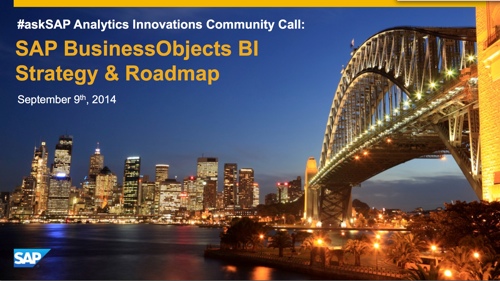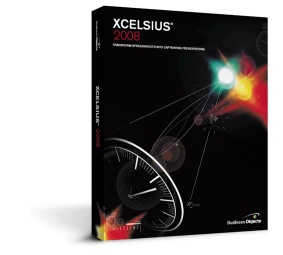This Tuesday, Apple unveiled its new iPhone and Watch. While I wouldn’t consider it an unveiling- as most of the details were previously disclosed- SAP provided an #askSAP webcast to elaborate on its analytics roadmap (see related article, The Future of the SAP BI Platform, Again) and respond directly to questions posed by its customers. I caught three key messages from the #askSAP webcast.
We’re Listening
When I hear Jayne Landry speak, either directly or through her blogs, she always conveys the message that “we’re listening”. While we may quibble about the speed and direction of SAP analytics, I do believe that SAP is sincerely listening to its analytics customers more than they have in the past. Further evidence of this listening is Ty Miller’s news that SAP including Lumira Server as part of the BI platform license and creating a limited-use lower-cost HANA license to facilitate that. Even more shocking was Ty’s admission that SAP is looking at providing web access to Lumira visualizations without the need for HANA. If true, this is a welcome break from the HANA Everywhere messaging (see Steve Lucas’ SAP Insider article, SAP HANA Everywhere). I’m still confused on details and timeframes, but am looking forward to hearing more first-hand at this month’s ASUG SAP BusinessObjects User Conference in Fort Worth, Texas.
We’re Simplifying
Bill McDermott’s message of Run Simple is taking root throughout SAP, including analytics. Folding together tools for the analyst persona like Analysis, Live Office, Explorer and Lumira makes a lot of sense. So does keeping Crystal Reports and Web Intelligence largely intact. As a big Explorer fan, the news of its functionality moving to Lumira (and therefore HANA) makes me nervous, but I’m curious to see how Explorer’s road map might change in light of Lumira w/o HANA (see previous paragraph). Sure, we all wish things would move along faster (see related article, The Future of the SAP BI Platform, Again), but I have no doubt that SAP executives agree with customers on this point.
We’d Really Rather You Didn’t Buy Those Other Smartwatches Analytics Tools
I’ve spent a lot of time this week thinking about why Apple announced a product (the Apple Watch) that won’t be available until 2015. I came up with two reasons. First, Apple wants to give developers plenty of lead time to support the watch with their apps. Second, and I believe more important than the first, Apple wants to suck the oxygen out of the smartwatch room. “Don’t even think of buying an Android watch for Christmas because we’ll have you covered in 2015.” (Fast Company came up with three theories).
SAP employed a similar strategy to Apple’s this week. At first, I wondered why SAP would schedule the webcast on a day where any news was likely to get buried under the deluge of Apple coverage. But September 9 was also the day of Tableau CEO Christian Chabot’s keynote from the Tableau Customer Conference as well as their financial analyst day (I still haven’t watched either presentation but hope to get caught up over the weekend). It’s no coincidence that SAP planned their webcast on the same day as Tableau’s keynote (and that Tableau was the only competitor mentioned by name in Steve Lucas’ latest blog post). It’s year-end budgeting time. And SAP would be eternally grateful if customers based their desktop data visualization strategy around Lumira. And keep those pesky land-and-expand Tableau desktop licenses out of the capital budgets because it isn’t the enterprise standard application dictated by corporate IT (remember those guys?).
The roadmap made clear which direction the SAP Big Data bus is headed in. But what remains unclear is when it will arrive with shipping software. No doubt we’ll be hearing more at the ASUG SAP BusinessObjects User Conference and throughout the rest of 2014.
What did you take away from the #askSAP webcast? Be sure to place your vote for which 80’s hit captures your reaction to the #askSAP webcast for BI Strategy and Direction?
For Further Reading
- Follow the #askSAP conversation on Twitter
- SAP Clarifies BI Roadmap, Takes on Questions on #askSAP Webcast by Courtney Bjorlin/ASUG News
- Times They Are a Changin’ by Greg Myers on EV Technologies blog
- My takeaways from the “#askSAP Analytics Call: SAP BusinessObjects BI Strategy and Roadmap” by Ronald Konijnenburg/SAP Community Network
- The Countdown on Data Visualization Has Begun – Top Ten Reasons Why SAP Will Deliver by Steve Lucas/SAP



I’m concerned that simplification would only cause less support for BW/BEx.
Business Objects was acquired and offered as a premium solution to BEx reporting tools — BEx Analyzer, BEx Web Analyzer, and Web Application Designer. Till now, Business Objects hasn’t been able to fully support the features available with BEx reporting tools. You can see this in Note 1869560 – SAP BusinessObjects BI Support Matrix for SAP NetWeaver BW. Additionally, issues with security complexity and lack of full Netweaver Portal KM support have been created for those users who have fully implement the BEx framework and want enhancements that Business Objects offers.
SAP should better support its BW customers since these customer use other SAP software like ECC.
Here’s some numbers from SAP about BW as of Feb 2014. 14500+ customers
200 New Installations/Month
3500+ 7.3 customers
850+ BW on HANA customers
Note that majority of customers still are not on HANA and given the cost of HANA will probably never be. I think that Business Objects needs to better support BW customers especially those who don’t have HANA. In order to do this, I think that Business Objects should be split into three platform lines:
SAP BW/Netweaver
SAP HANA
Windows/Unix/Database Independent.
Splitting out Business Objects to support solely on the SAP BW/Netweaver platform would allow a chance for Business Objects to be truly a premium reporting solution to BEx Web Analyzer, Analyzer, and Web Application Designer by better supporting and enhancing the BEx semantic layer, BW security, Netweaver Portal user interface, KM collaboration support on the J2EE platform. Also, there would be proper focus on this platform. Why didn’t Lumira support BW/BEx when it first came out? Why was the focus only on the Business Objects Universe and HANA initially? Doesn’t SAP care about its BW customers who can’t afford to go to HANA?
The HANA platform solution would get rid of the abap and java stack (J2EE, Tomcat, etc). All code would be on the HANA platform itself. This will give a chance for HANA to show that it can serve as a solutions platform. Business Objects on HANA can have its own semantic layer and security which can evolve separately and not be tied down with the older ABAP and JAVA frameworks.
The Windows/Unix/Database Independent version of Business Objects is now free to expand on the universe semantic layer and security without being tied down by BW and HANA requirements.
Mel,
Thanks for writing. My perspective is mainly as a “classic BusinessObjects customer”, so I appreciate hearing the perspective of a SAP Business Suite/BW customer. Most of the new headlining features in the SAP BusinessObjects BI 4.0 suite where regarding simplified BW integration and access, so we “classic” customers originally felt very slighted by SAP. You’re not the first BW customer to tell me you also feel slighted by SAP.
Remember that SAP Visual Intelligence (the original name of Lumira) actually only supported HANA as a data source and didn’t add support for universes until a few months later. BEx support was recently added in version 1.17 (see article by Ahmed Sherif, SAP Lumira 1.17 Now Available with Direct Access to BEx Queries). A new version of Lumira appears roughly every 6 weeks (version 1.19 is the most recent) and everyone can expect it to mature over time. My best guess is that BEx support simply took longer to integrate into the product and shouldn’t be perceived as a lack of interest on SAP’s part.
Regarding HANA, like any new technology, I believe its cost will drop over time. The HANA value proposition is not only about cost but speed, and I believe that HANA adoption will accelerate as customers see the benefits achieved by HANA’s early adopters. But I also believe that HANA doesn’t simplify life for customers that don’t use the SAP Business Suite, but instead gives them yet another technology platform to support. These customers are also bristling at SAP’s insistence of HANA, particularly as the platform for Lumira Server, but SAP is actually making product announcements to address the concerns of these “agnostic” customers.
I’m currently at the ASUG SAP BusinessObjects User Conference in Ft. Worth, Texas. Steve Lucas made some interesting announcements yesterday and I expect Jane Landry to make more today. I’ll write up some analysis and commentary once I have all the details and time to reflect on them.
Again, thanks very much for writing and sharing your perspective,
Dallas
Thanks, Dallas.
I doubt SAP will ever drop their HANA prices — not willingly. If it does, it will only be through other database catching up with HANA. If SAP HANA prices start going down, will customers be more willing to wait it out for more price drops? Will customer who bought HANA earlier ask back for some of the money paid out?
Here’s BW on MS SQL server with near HANA speeds.
http://scn.sap.com/community/sqlserver/blog/2014/06/25/experiences-with-sql-server-column-store-indexes-and-sap-bw
What I don’t like is that even though that other databases are catching up. SAP is only putting the new capabilities in BW if you have HANA. All new BW features should be supported on all database that SAP currently support now with BW, and let the customer have the choice of dealing with a slower performing database. If HANA speed is required, then the customer will buy it.
I didn’t know Lumira support for BEx is already out. Thanks for this.
I really believe that the only way Business Objects could ever truly be well integrated with BW is for to SAP split Business Objects into these three platforms. I don’t see how they can truly support the semantic layers and security frameworks for BW, HANA, and Business Objects universes.
Having better integration with SAP BW will slow down or prevent the “Land and Expand” strategy that Tableau and Qlikview have that are happening at many BW installations. SAP products should work best with other SAP products — SAP should protect its customer base.